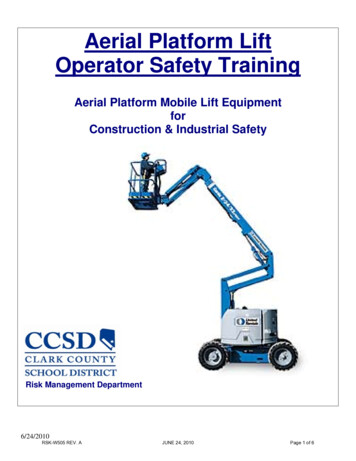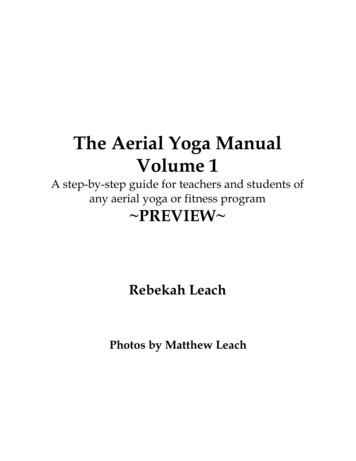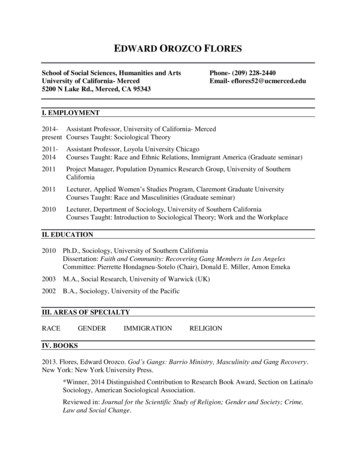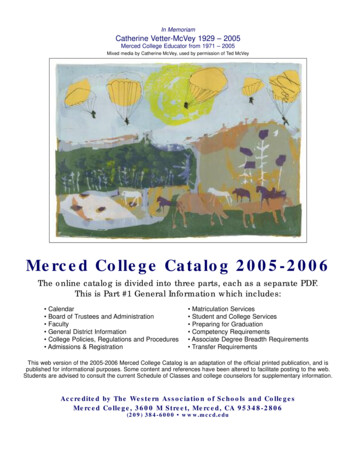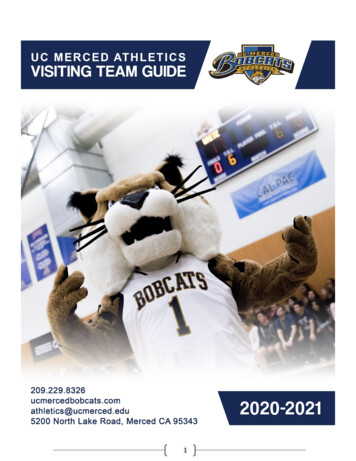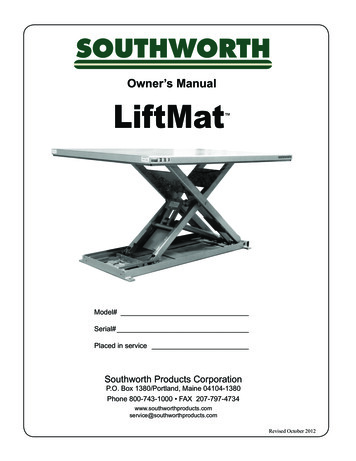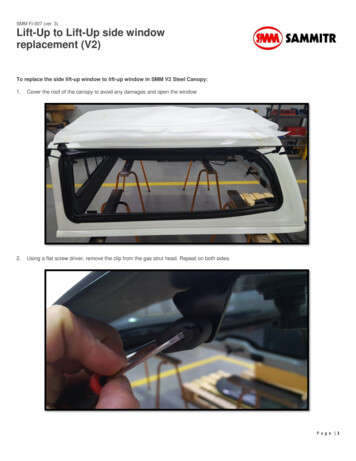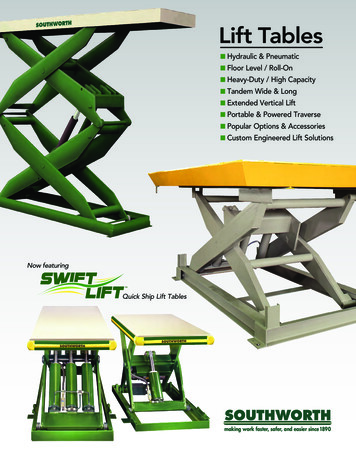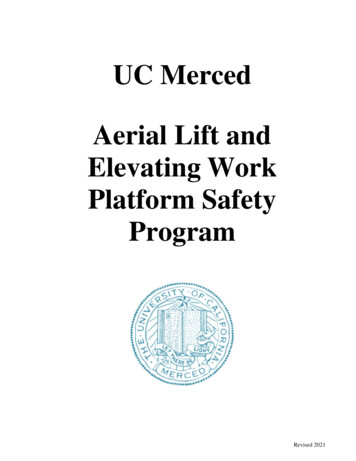
Transcription
UC MercedAerial Lift andElevating WorkPlatform SafetyProgramRevised 2021
Aerial Lift and Elevating Work Platform SafetyProgramTable of ContentsSectionPage1.0PURPOSE . 32.0APPLICABILITY/SCOPE . 33.0ROLES/RESPONSIBILITIES . 33.1UCM Staff, Faculty and Students . 33.2Departments that own/use AL/EWP . 33.3Department Safety Coordinators and/or “Responsible Person”. 33.4AL/EWP Equipment Operators. 33.5Contractors/Vendors using AL/EWP on UCM Property . 33.6EH&S – (Aerial Lift/Elevating Work Platform Safety Program Manager) . 44.0DEFINITIONS . 45.0TYPES OF AERIAL LIFT/ELEVATED WORK PLATFORMS . 55.1Extensible Boom Platform . 55.2Scissor Lift . 56.0PROGRAM REQUIREMENTS/OPERATOR PROCEDURES . 66.1Administrative Requirements . 66.1.1 Identify/Evaluate AL/EWP Equipment Requirements and Site Hazards . 66.1.2 Inventory Department AL/EWP Equipment . 66.1.3 Identify Department Personnel Requiring AL/EWP Equipment Training . 66.1.4 Assure Training/Qualification/Retraining of Department Personnel . 66.2Operator Training/Licensing Procedures . 66.2.1 Written/Classroom Training . 76.2.2 Hands-On/Field Training/Testing . 76.2.3 Operator Licensing . 76.2.4 Refresher Training . 87.0OPERATOR SAFE-WORK PROCEDURES . 87.1AL/EWP Selection and Site Hazard Evaluation . 87.2Pre-Operation Inspection and Use of Fall Protection . 87.3“Equipment Tag Out” for Repair . 98.0OPERATING PROCEDURES/HAZARD IDENTIFICATION AND CONTROLS . 109.0TRAINING REQUIREMENTS . 119.1All UCM Staff, Faculty and Students . 119.2Departments that own Aerial Lifts or Elevating Work Platforms . 119.3Department Safety Coordinators and/or “Responsible Person”. 119.4Aerial Lift/Elevating Work Platform Operators . 119.5Contractors using Aerial Lift/Elevating Work Platforms on UCM property . 119.6EH&S – (Aerial Lift/Elevating Work Platform Safety Program Manager) . 119.7EH&S Trainer/Program Manager . 1210.0RECORDKEEPING REQUIREMENTS . 1210.1Departments that own/use Aerial Lifts or Elevating Work Platforms . 1210.2Aerial Lift/Elevating Work Platform Operators . 1210.3EH&S – (Aerial Lift/Elevating Work Platform Safety Program Manager) . 1211.0REFERENCES . 1212.0ISSUED BY AND NEXT REVIEW DATE . 1313.0ATTACHMENTS . 13
Aerial Lift and Elevating Work PlatformSafety Program1.0PURPOSEThis program guides all aspects of the Aerial Lift/Elevating Work Platform Safety Program for theUniversity of California at Merced. As mandated by Cal/OSHA and other regulatory compliance codes,this program requires departments that own and/or operate Aerial Lifts/Elevating Work Platforms(AL/EWP) to train and license personnel who operate their equipment, conduct pre-operation safetyinspections and preventive maintenance of the equipment, and adhere to specific safe-work practiceswhenever using these types of powered industrial equipment.2.0APPLICABILITY/SCOPEThis program applies to all University of California at Merced Faculty, Staff and Students who arerequired or request to operate Aerial Lift/Elevating Work Platform (AL/EWP), or who must overseepersons operating AL/EWP, for any portion or aspect of their research, instruction and/or work.3.0ROLES/RESPONSIBILITIES3.1 UCM Staff, Faculty and StudentsAll UC Merced Faculty, Staff and Students who are required or requested to operate AL/EWP, orwho must oversee persons operating AL/EWP, must know about the requirements of this program.All operators are required to be trained in the safe operation of AL/EWP resulting in 3-year licensureto operate specific types of AL/EWP equipment.3.2 Departments that own/use AL/EWPDepartments that own, operate, or allow the operation of AL/EWP at their facilities assure that allUC Merced Faculty, Staff, or Student operators in their Department have current AL/EWP licensureissued by the Office of Environmental Health & Safety (EH&S). They also must designate DSC oranother Responsible Person to oversee program implementation with the Department.3.3 Department Safety Coordinators and/or “Responsible Person”The person assures that all aspects of this program are implemented in their Department includingcurrent operator licensure from EH&S, scheduling training/retraining as needed, and maintainprogram training and inspection records.3.4 AL/EWP Equipment OperatorsAll Aerial Lift or Elevating Work Platform operators must obtain an Operator’s License from EH&Sprior to operating AL/EWP equipment. This license is obtained by successfully completing a twopart “AL/EWP Safety Training” conducted by EH&S. This includes classroom/online training plushands-on training followed by documented quiz/testing.3.5 Contractors/Vendors using AL/EWP on UCM PropertyContractor or Vendor employees that have been trained under their company’s Aerial Lift/ElevatingWork Platform Safety program, and have a UC Merced Department’s permission, may operateAL/EWP equipment owned/leased/rented by their employer on UC Merced premises. Contractorswho use AL/EWP equipment that is owned and/or rented/leased by a UC Merced Department mustPage 3 of 20
Aerial Lift and Elevating Work PlatformSafety Programdemonstrate to the Department’s DSC or Responsible Person their current licensure for operation ofthe specific type of AL/EWP before they are allowed to operate the UC Merced owned/leased/rentedequipment. Whether the operator is a vendor or contractor, they may be required to show verificationthat they have been trained and licensed on the specific AL/EWP equipment being operated by anyUC Merced Department representative. If contractor/vendor employees are found to be unlicensed,all work must stop immediately until properly licensed personnel are present to operate the AL/EWPequipment.3.6 EH&S – (Aerial Lift/Elevating Work Platform Safety Program Manager)Fleet manages this program in conjunction with EH&S for UCM through the direction of the “AerialLift/Elevating Work Platform Safety Program Manager.” This person is responsible for all aspectsof managing and implementing this program including: 4.0Assures this program is revised periodically to maintain compliance with codes andregulations as they change, and update as need may dictate.Communicates program changes, objectives and requirements to all departments impactedby this program.Develops and updates training content as needed.Manages program databases and records of Operator Licensure.Conducts ‘hands-on’ field t raining and assessment of Operator trainees.Works with client departments to develop training for unique and “department-specific”Aerial Lift or Elevating Work Platform needs.Works with client departments to find safe locations to conduct ‘hands-on’ field training.Conducts periodic program audits at client departments to assure the program is beingproperly implemented and followed.Conducts periodic “customer service” inquiries to learn how the program can be modifiedto better meet client department need.Modifies program content and procedures as needed to improve program effectiveness andease of implementation and tracking.DEFINITIONSAerial Device: Any vehicle mounted or a self-propelled device that is telescoping extensible,articulating, or both, and is primarily designed to position personnel.AL/EWP: Acronym for “Aerial Lift/Elevating Work Platform”Boom: An elevating member, the lower end of which is so attached to a rotating or non-rotatingbase that permits elevation of the free end in the vertical plane.Counter Weight: The rear section or area of the lift which is usually made of solid steel, and/orcombination of steel and the weight of the battery on electric lifts, that counter balances the boomleverage and basket load.Data Plate: Manufacturer’s equipment specification and information data, which includes basketload rating/lift capacity, lift heights, vehicle weight, and vehicle attachments. This plate is requiredPage 4 of 20
Aerial Lift and Elevating Work PlatformSafety Programto be affixed to all Aerial Lift Equipment by regulatory code. This is the vehicle operator’s primarysource of basic information about their vehicle for safe-work and use planning.Emergency Lowering Means: Any elevating work platform equipped with a powered elevatingassembly, and having a platform height exceeding 60 inches, must be supplied with safe means oflowering the basket or platform during an emergency or malfunction.Fall Protection: An approved full-body safety harness with lanyard is to be worn at all times andattached to a secure anchor point when drivers or personnel are using a boom-type lift or vehiclemounted lift. Fall protection must also be worn when using scissor lifts on uneven surfaces or nearlocations with tip-over hazards.Guard Rails: Railing around the perimeter of the work platform. This railing consists of a top railbetween 39” – 45” with a mid-rail. Units with the top rail less than 39” must have fall protection inuse to operate.Lower Controls: Operating controls located on the base of the unit which can be switched tooverride the basket or platform control during an emergency.Mast: Part of the lifting mechanism to which the hydraulic lift cylinder or worm drive is attachedthat supports the basket as it is lifted up and down.Out Riggers: Extendable legs that are either manually set in place or, in some cases, hydraulicallyextended to give added stability to the unit base.Platform: Any personnel carrying device (bucket, basket, cage, stand, tub, or equivalent) which isa component of an aerial device.Upper Controls: Operating controls located on the basket or work platform of the unit. Thesecontrols can only be overridden with the operator’s permission or in case of an emergency.5.0TYPES OF AERIAL LIFT/ELEVATED WORK PLATFORMS5.1 Extensible Boom PlatformAn aerial device (except ladders) with an extensible boom. Telescopic boomswith personnel platform attachments are considered to be extensible boomplatforms.Fall Protection is required when operating this equipment.5.2 Scissor LiftA device designed to elevate a platform in a substantially vertical axis. Thisdevice can be driven by an operator inside the work platform and is generallydesigned to carry more than one person.Fall Protection is not required when operating this Lift but is highlyrecommended.Page 5 of 20
Aerial Lift and Elevating Work PlatformSafety Program6.0PROGRAM REQUIREMENTS/OPERATOR PROCEDURES6.1Administrative RequirementsDepartment Management is responsible for purchasing/owning or selecting/leasing the AL/EWPequipment and must designate the person(s) responsible for implementing the following programrequirements:6.1.1 Identify/Evaluate AL/EWP Equipment Requirements and Site HazardsBased upon the Operator’s AL/EWP use, and the “Site Evaluation Checklist” for each type ofAL/EWP equipment, the Department determines hazards throughout the Departmentencountered during AL/EWP use, and procures and outfits AL/EWP that will safely operate inthe Department’s work environment with the anticipated maximum reach and work platformcapacity required. Unusual or potential hazardous locations or operations in a Department’swork environment are marked with appropriate warnings via signage and paint striping, orreduced through Operator training and appropriate equipment selection/maintenance.6.1.2 Inventory Department AL/EWP EquipmentThe department conducts and maintains an inventory list of AL/EWP Equipment owned/usedby the Department. This list is used to identify training needs, equipment maintenancerequirements, and to identify and limit equipment to safe use for department business activities.This list is updated periodically as the Department procures or retires equipment and isreferenced to determine what equipment requires Operator’s Licensure for use. Refer toAttachment 1 for a template that may be used to develop your department’s AL/EWP “LiftEquipment Inventory”.6.1.3Identify Department Personnel Requiring AL/EWP Equipment TrainingThe department identifies specific Department Personnel and others who are allowed to operatethe Department’s AL/EWP. This list is used to identify training needs and to identify and limitequipment to safe use for department business activities. This list is updated periodically as theDepartment manages compliance with this program, when lifting needs and/or equipmentchanges, and when personnel are enrolled in or leave this program. Refer to Attachment 2 for atemplate that may be used to develop your department’s AL/EWP Equipment “LicensedOperator List,” or enroll personnel in the University’s Learning Management System (LMS) forthe AL/EWP Safety Program online.6.1.4Assure Training/Qualification/Retraining of Department PersonnelCal/OSHA requires that all AL/EWP equipment operators are enrolled in and receive initialtraining, and retraining at minimum every three years. See the training section of this programfor details on training requirements and activities.6.2Operator Training/Licensing ProceduresPage 6 of 20
Aerial Lift and Elevating Work PlatformSafety ProgramEach operator must successfully complete Operator Safety Training prior to operating AL/EWPequipment on UCM property. Operators may only use the AL/EWP equipment type they have beentrained and licensed to operate, or when under the direct supervision of persons who have theknowledge training and experience to train operators and evaluate their competence “in the field.”Training is conducted in a location where such AL/EWP equipment operation does not endangerproperty, the trainee, or others. Departments must arrange for their personnel to be licensed by EH&Sto operate AL/EWP equipment.Each supervisor or “responsible party will ensure that each AL/EWP operator is competent tooperate AL/EWP equipment safely and in compliance with Cal/OSHA requirements, asdemonstrated by the successful completion of the training and evaluation specified below. Trainingconsists of a combination of written, classroom, followed by hands-on “field” training anddocumented testing that’s specific to the AL/EWP equipment. Please contact EH&S at (209)6423073 to arrange training for Department personnel.6.2.1Written/Classroom TrainingWritten/classroom training includes familiarization with equipment types and components,hazard assessments and mitigation, equipment inspection requirements, and other requirementsof this program. Upon successful completion of classroom training, the trainee then takes handson training in the field. EH&S and FM tracks owner Department training records.Classroom training is verified through a written final exam that demonstrates the trainee’sunderstanding of basic AL/EWP operation and safety. Completion of this classroom trainingexam with a passing grade of 70% or more is required before the scheduling of hands-on/fieldtraining. Records of completed exams are kept by the LMS, and also optionally by theDepartment in the trainee’s personnel file.6.2.2Hands-On/Field Training/TestingThe “Hands-On” training and testing is conducted using a representative piece of AL/EWPequipment under the direct supervision of the EH&S Trainer and/or AL/EWP Safety Programmanager who has the knowledge, training and experience to train AL/EWP operators andevaluate their competence. Field training using AL/EWP equipment includes demonstrationsperformed by the trainer, practical exercises performed by the trainee and observed by thetrainer, as well as evaluation of the trainee’s successful performance on a standard ‘skillsassessment’ course that is documented for recordkeeping purposes on the LMS by EH&S.6.2.3Operator LicensingWhen the trainee successfully completes both written and hands-on testing, UC Merced EH&Scertifies and then “licenses” that the Operator has been trained and evaluated as required by thisprogram and Cal/OSHA. The license includes the name of the operator, the licensure/trainingdate, the name of the person(s) performing the training or evaluation, and the types (equipmentmodels) of AL/EWP the operator is/are licensed to operate.Page 7 of 20
Aerial Lift and Elevating Work PlatformSafety ProgramAn Operator’s License is issued by the training company. It i s usual l y a credit-card sizedand must be carried by the Operator whenever they are operating an AL/EWP on UC Mercedproperty. This is a one-time training with no expiration date. However, retraining may be required ifequipment, job tasks or environmental conditions change significantly from those when originaltraining took place. The Operator is responsible for identifying situations where additional/retraining/licensure may be needed and alerting their Department’s DSC/Responsible Person.6.2.4Refresher TrainingCal/OSHA requires refresher training to ensure the Operator has the knowledge and skillsneeded to operate AL/EWP equipment safely when: The Operator has been observed to operate the AL/EWP in an unsafe manner.The Operator has been involved in an accident or near-miss incident.The Operator has received an evaluation that reveals that the Operator is not operating theAL/EWP safely.The Operator is assigned to a different type of AL/EWP that they haven’t been trained on.A condition in the workplace changes in a manner that could affect safe operation of theAL/EWP.Training content is determined by the AL/EWP Safety Program Manager/Trainer based uponobserved hazards, type of equipment, Department need, and work requirements. If an Operatorhas previously received training in a topic specified in this program, and such training isappropriate to a new AL/EWP and/or working conditions, additional training in that topic is notrequired if the Operator has been evaluated and found competent to operate the new AL/EWP,or in the new working conditions, safely.7.0OPERATOR SAFE-WORK PROCEDURES7.1AL/EWP Selection and Site Hazard EvaluationPrior to conducting work with an AL/EWP, an Operator conducts a “Site Evaluation” and a “LiftSelection Assessment.” This assessment is conducted as environmental hazards and job requirementsdictate, but is formally completed by every Operator at the beginning of working in a new orunfamiliar location, or when new or unfamiliar hazards are identified. This assessment ensures thatthe proper AL/EWP equipment is selected for the work, and that all hazards in the work area areidentified and mitigated prior to commencing work. On the reverse side of each lift “Pre-operationInspection Form” (Attachments 4 – 5) is a written checklist for “Site Evaluation” that may be used todocument the Operator’s assessment of their work environment. This site evaluation checklist mayalso be used to assess the Department’s general work environment to determine appropriateequipment procurement needs.7.2Pre-Operation Inspection and Use of Fall ProtectionPage 8 of 20
Aerial Lift and Elevating Work PlatformSafety ProgramAt the beginning of each work shift, or prior to using AL/EWP equipment for a new work assignment,the Operator conducts a documented “Pre-Operational Inspection” of the equipment. This inspectionis specific to the type of lift equipment. Results of this inspection are documented on inspectionchecklists.Some types of AL/EWP equipment require that fall protection must be worn and properly attached tothe equipment by the Operator of the equipment. The use of Fall Protection equipment is regulated byCal/OSHA and outlined on the EH&S website’s “UCM Fall Protection Program.” The use of fallprotection gear is always recommended by EH&S, but the requirement or option to wear fall protectionis outlined on the Pre-Operation Inspection Checklists listed below based upon equipment type.Refer to the following program attachments for Pre-Operation Inspection Checklists and SiteEvaluation Forms to determine need for fall protection, document inspections and conduct HazardEvaluation/Equipment Selection for work sites. Elevating Work Platform Site Hazard Assessment – Attachment 3 Extensible Boom Platform – Attachment 4 Scissor Platform Lift – Attachment 57.3“Equipment Tag Out” for RepairNo AL/EWP equipment is to be used until any deficiency(s) discovered during Pre-OperationInspection are corrected. If a hazardous deficiency is discovered during a Pre-Operation Inspection,the Operator alerts their Supervisor of the condition, and “Tags Out” the equipment from being usedby controlling all keys for the vehicle, and placing a “Warning Tag” in the area near the controls withthe following information: Person’s name that has “Tagged Out” the vehicle and has the keys in their possession as wellas their contact information. Date vehicle was “Tagged Out.” Reason(s) for “Tagging Out” the vehicle including all noted deficiencies. (A photocopy of thecompleted inspection form may be taped to the basket or steering wheel on a vehicle-mountedlift for this purpose.) Name and contact information for the Department’s responsible person for implementation ofthis program.No repairs are made on any AL/EWP until the equipment and its components are blocked, tagged,locked out or otherwise made safe for repair work to commence according to application of the UCMerced Energy Isolation Program (Lockout/Tagout).Page 9 of 20
Aerial Lift and Elevating Work PlatformSafety Program8.0OPERATING PROCEDURES/HAZARD IDENTIFICATION AND CONTROLSPrior to operation at the beginning of each work-shift, Operators must review and assess the followingequipment/work area conditions:1. Review work area for hazards and remove/control them prior to operation.2. Always conduct an environmental hazard assessment prior to selecting/using AL/EWP equipment.3. Only use AL/EWP equipment designed to safely work in the work-area conditions observed.4. Review operating instructions, warnings, and precautions for the types of AL/EWP being operated.5. Prior to operation at the beginning of the work-shift, inspect and document the equipment’s properfunction of controls and instrumentation. Do they operate correctly?6. Inspect engine or motor operation.7. Inspect steering and maneuvering.8. Familiarize yourself with visibility.9. Inspect basket or platform capacity and equipment stability.10. Complete and document the inspection process using the appropriate inspection form (in“Attachments”)11. Check fuel and/or charging of batteries and refuel/recharge as needed.12. Review and understand equipment operating limitations.13. Review other operating instructions, warnings, or precautions listed in the operator’s manual forthe types of AL/EWP that you will operate.14. Alert all persons in the work area of intended work activities and hazards.15. Always face the direction of travel.16. Don’t travel horizontally with the platform elevated or extended.17. Don’t exceed the basket or platform capacity.18. Position equipment on a firm level surface and minimize blocks or ramps for leveling the AL/EWPequipment.19. Always set outriggers prior to use if the AL/EWP is equipped with them.20. Wear proper safety harnesses and only tie-off to the work platform’s fall protection tie-off point(Refer to “Types of Lifts” and the Inspection Forms in the “Attachments” to determine if safetyharnesses are required to be worn.)21. “Barrier off” the lift swing work-area below the AL/EWP equipment’s work zone.22. Don’t climb on guardrails, climb on ladders or stand on other items when working on the platform.23. Practice good housekeeping when working in and around the platform.24. Never drop or throw objects to or from the work platform.Page 10 of 20
Aerial Lift and Elevating Work PlatformSafety Program25. Always look below platform and confirm it’s safe to lower the equipment before lowering theequipment.26. Never lean the platform on or against structures.27. Never use the boom to push against something or try and pull the AL/EWP equipment along in ahorizontal direction.9.0TRAINING REQUIREMENTS9.1All UCM Staff, Faculty and StudentsAre trained on the basic requirements of this program with the primary knowledge that they must betrained and licensed to operate an Aerial Lift or Elevating Work Platform prior to doing so on UCMproperty.9.2Departments that own Aerial Lifts or Elevating Work PlatformsAre familiar with the Administrative and Personnel Training Procedures of this program andimplement/integrate them into their research/work/business practices.9.3Department Safety Coordinators and/or “Responsible Person”Receive detailed training and support from the Aerial Lift/Elevating Work Platform ProgramManager at EH&S concerning their roles/responsibilities in implementing/integrating this programinto their Department’s research/work/business practices.9.4Aerial Lift/Elevating Work Platform OperatorsMust enroll with EH&S and successfully complete the classroom training with quiz, as well as HandsOn “Field” Training for each model of Aerial Lift or Elevating Work Platform they will be “Licensed”to use.9.5Contractors using Aerial Lift/Elevating Work Platforms
3.6 EH&S - (Aerial Lift/Elevating Work Platform Safety Program Manager) Fleet manages this program in conjunction with EH&S for UCM through the direction of the "Aerial . Any vehicle mounted or a self-propelled device that is telescoping extensible, articulating, or both, and is primarily designed to position personnel.


